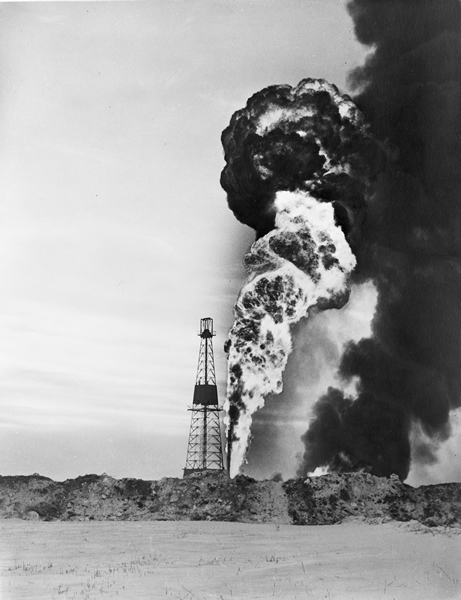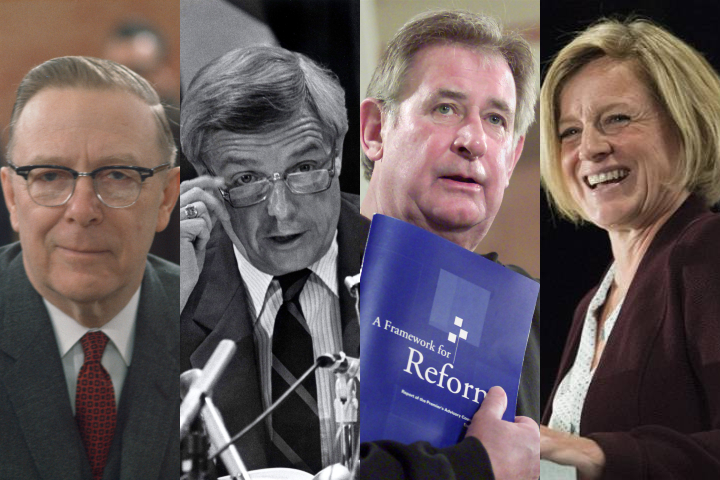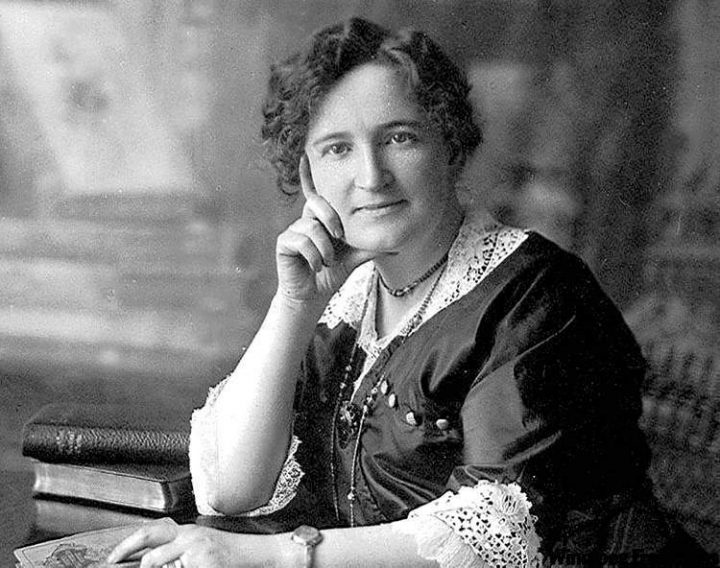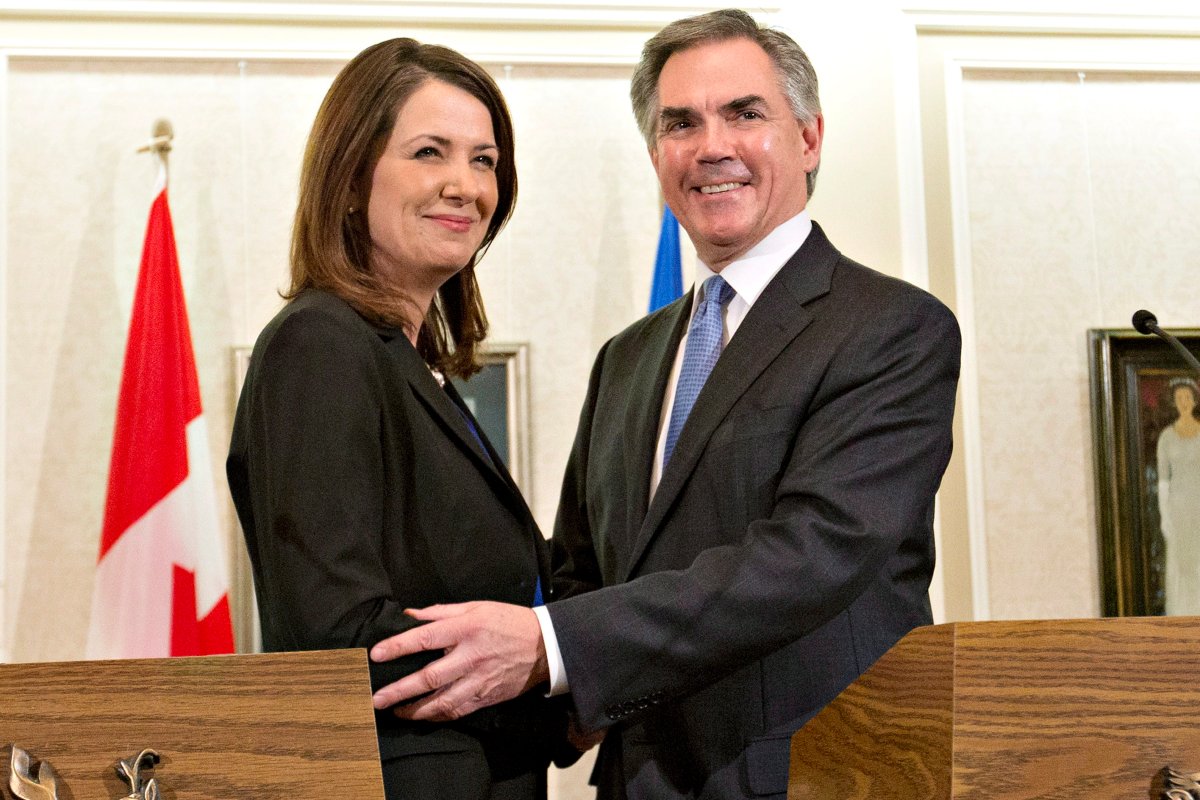Since the formation of the province of Alberta in 1905, parties have governed in multi-year dynasties: the Liberals, the United Farmers, and Social Credit followed by 44 consecutive years of Progressive Conservative governments.

Here’s a chronology of Alberta elections:
Nov. 9, 1905: Lawyer Alexander Rutherford, son of an immigrant farmer from Scotland, leads the Liberals to a lopsided victory over R.B. Bennett’s Conservatives, taking 22 of 25 legislature seats. Bennett would go on to become prime minister.
READ MORE: Find your riding and candidates for the 2019 Alberta election
March 22, 1909: Another sweep for the Liberals with 36 of 41 seats, largely due to support from farmers and immigrants.
Rutherford, however, gets the boot. Public outrage over a generous contract awarded to a railway to build a line to Fort McMurray forces him to resign in 1910.

April 17, 1913: Liberals choose Alberta Chief Justice Arthur Sifton as premier in a bid to restore public trust. He leads them to their third consecutive victory — winning 39 of 56 seats — and into Prohibition.
Women win the right to vote provincially in 1916.
June 7, 1917: Liberals keep their grip on power with 34 of 56 seats. Women vote for first time provincially, but must wait two more years for the right to vote federally.
The first oil boom in Turner Valley goes bust. Alberta has one of the highest enlistment and casualty rates of the First World War. More than 45,000 head off to fight; more than 5,000 don’t return.
READ MORE: Alberta election promise tracker — Where do the parties stand on the major issues?
July 18, 1921: Farmers and miners, disenchanted with old-line parties, sweep Liberals from power. The United Farmers of Alberta, led by Henry Wise Wood, win 38 of 61 seats but Wood declines to be premier. His caucus chooses farmer Herbert Greenfield.
Alberta’s Famous Five — Nellie McClung, Emily Murphy, Louise McKinney, Irene Parlby and Henrietta Edwards — begin their fight for women to be recognized in law as ”persons.” Prohibition is repealed in 1923.
June 28, 1926: John Brownlee, who succeeds the ineffectual Greenfield in 1925, leads the UFA to a second term, winning 43 of 61 seats.
A bookish lawyer tutored by Bennett, Brownlee begins balancing budgets, selling provincially owned railways and securing control of natural resources. The British Privy Council in 1929 declares that women may hold public office.
June 19, 1930: Neo-conservative Brownlee takes the UFA to a third term with 39 of 63 seats but soon faces heat over his policies and personal life.
He is dragged into court in a sex scandal. He resigns as premier in July 1934 and is replaced by R.G. Reid.
The Great Depression produces soup kitchens, bread lines and protests.
Aug. 22, 1935: A Boston newspaper headline screams “Alberta Goes Crazy” as William Aberhart’s Social Credit League sweeps to power amid drought and farm bankruptcies.
The radio evangelist, dubbed “Bible Bill,” mixes politics and religion to grab 56 of 63 seats, but is unable to keep his promise to pay each Albertan a monthly $25 dividend.
By 1936, with Alberta’s debt and interest payments sucking up half the province’s annual revenue, Aberhart increases income taxes and introduces a sales tax. Some 22 backbenchers call for his resignation.
March 21, 1940: Aberhart wins another term, taking 36 of 57 seats. The victory comes despite his decision to repeal an MLA recall act when it is employed against him and despite his introduction of a raft of other laws the Supreme Court finds unconstitutional. Among them is one that attempts to muzzle the news media.
When Aberhart, 64, dies in 1943, he is succeeded by trusted lieutenant Ernest Manning.
READ MORE: How Global News is covering Alberta election 2019
Aug. 8, 1944: Moving the Socreds further to the right, Manning wins 51 of 57 seats. While Aberhart had battled big banks; Manning wages war on socialism.
Nearly half of the province’s adult male population enlists to fight in the Second World War. Oil is discovered near Leduc, just south of Edmonton. Coalfields are booming.

Aug. 17, 1948: Manning takes 51 of 57 seats. After lobbying Ottawa to return 22,000 Japanese war detainees to British Columbia, he relents and gives them permission to remain.
Manning drags Alberta out of debt. The discovery of seven more oilfields puts the province on the path to prosperity.
Aug. 5, 1952: Another huge majority for Manning. The Socreds win 53 of 57 seats. After initial reluctance, Alberta agrees to ship natural gas to Central Canada. Two pipelines are constructed.
June 29, 1955: Manning wins another election, but this time with a slimmer majority. Socreds take 37 of 61 seats.
The economic boom continues. By 1957, Alberta spends more per capita than any other province. In 1957 and 1958, the Socreds give Albertans $21 million in oil dividends.
June 18, 1959: Manning clinches another huge majority, winning 61 of 65 seats on a platform of free enterprise and opposition to national medicare and bilingualism.
Despite personal views against lewd behaviour and drinking, Manning eases restrictions on movie censorship and booze.
June 17, 1963: The Manning machine roars along, gobbling 60 of 63 seats. Despite the premier’s strong commitment to individualism and opposition to socialism and unions, Alberta’s per capita spending on social services exceeds the national average.
Manning’s government gives Aboriginals the right to vote in provincial elections.
May 23, 1967: Manning wins his seventh election. Harvard-trained lawyer Peter Lougheed comes onto the political scene, picking up six seats for the Progressive Conservatives and capturing 26 per cent of the vote.
Manning resigns in 1968 to enter the corporate world, leaving behind a stunned caucus and no obvious successor. Harry Strom, a soft-spoken rancher, fails to spark new life in the party.
Aug. 30, 1971: Campaigning on the need for change without criticizing the Socreds, Lougheed’s Tories win 49 of 75 seats. The Socreds are reduced to a 25-member opposition.
Lougheed begins delivering on the party’s 120 election promises and repeals Alberta’s sexual sterilization law.
Good times begin to roll. Over the next decade, Alberta’s gross domestic product increases sixfold.
March 26, 1975: Tories win 69 of 75 seats. Lougheed establishes the Heritage Savings Trust Fund with skyrocketing oil and gas revenues, promotes Fort McMurray’s oilsands and rattles sabres with Ottawa over ownership of resources.
March 14, 1979: Lougheed continues to wage war with Ottawa over oil-pricing controls that economists estimate cost the province $50 billion.
Albertans reward him with another resounding majority — 74 of 79 seats. Anger with Ottawa over oil policy sees birth of the bumper stickers: “Let the eastern bastards freeze in the dark” and “This car doesn’t brake for Liberals.”
Nov. 2, 1982: Recession hits Alberta but doesn’t dampen voter faith in Lougheed’s Tories, who win 75 of 79 seats.
But oil company layoffs signal an era of unemployment, bankruptcies and bank failures. Popular NDP Leader Grant Notley, one of only two New Democrats in the legislature, dies in a 1984 plane crash. Lougheed retires in 1985.
May 8, 1986: Don Getty gets the party nod and leads the Tories to another majority government. Tories win 61 of 83 seats.
Oil slips from US$44 to $10 per barrel and Getty is forced to put the brakes on spending. He hikes taxes and imposes cuts in health, education and social services.
March 20, 1989: Getty is punished for calling a snap election by losing his own seat, but his party remains in power with 59 of 83 seats. Getty later wins a byelection.
He survives a 1990 leadership challenge but huge losses of public money in bad government investments overshadow his tenure.
He steps down in 1992, leaving behind as part of his legacy February’s Family Day holiday.
June 15, 1993: Liberals under former Edmonton mayor Laurence Decore appear poised to seize power but lose the brass ring to populist Tory Ralph Klein.
Klein, a former Calgary mayor and Getty’s environment minister, had defeated cabinet colleague Nancy Betkowski (later Nancy MacBeth) in a leadership race.
Tories win 51 of 83 seats on a platform of severe program cuts, government downsizing and privatization of services.
March 11, 1997: The Tories ride Klein’s folksy appeal to a 63-seat majority. Despite Klein’s heavy cuts, his popularity is aided by big budget surpluses fuelled by lucrative oil and gas royalties. The Liberals, led by Grant Mitchell, win 18 seats.
March 12, 2001: Klein and the Tories capture 74 seats and win back parts of Edmonton, which had been shut out to them since the mid-1980s. Klein defeats former-Tory-rival-turned-Liberal-leader Nancy MacBeth, who fails to win her own Edmonton riding.
High oil and gas prices pump billions of dollars into the Alberta economy, allowing enough money to be set aside by April 2005 to pay off the balance of the $23-billion debt.
Nov. 22, 2004: The Tories record a 10th consecutive majority win but lose seats for the first time since Klein took charge in 1992. The NDP and Liberals make gains in Edmonton and, for the first time since 1997, the Liberals win in Calgary.
The new Alberta Alliance party elects its first member. Klein resigns as leader in 2006 after getting 55 per cent support in a leadership review.
March 3, 2008: Ed Stelmach takes over the Tories and returns the party to a large majority. It wins 72 of 83 seats while the Liberals take nine and the NDP two.
The Alberta Alliance, now named the Wildrose Alliance, loses its lone seat held by party leader Paul Hinman.
Despite the victory, Stelmach doesn’t survive the term. Faced with a recession that cripples the province’s finances, Stelmach runs Alberta’s first deficit in more than a decade and is forced out in 2011 by pressure from within the party.
April 23, 2012: With Klein’s debt-free legacy in tatters, the Tories and their new leader, Alison Redford, seem ripe for defeat. Much of the party’s socially and fiscally conservative base migrates to the Wildrose and its new leader Danielle Smith.
Several missteps in the final days of the campaign, coupled with Redford’s ability to win support from labour groups, leads to an unexpected Tory victory, although the majority is reduced to 61 seats.
Like Stelmach, however, Redford doesn’t survive a term rocked by spending scandals.
Smith and 10 other Wildrose members cross the floor to the Tories after Jim Prentice is elected leader and premier in 2014.
May 5, 2015: The NDP wins its first majority government toppling the Progressive Conservatives. The party under leader Rachel Notley sweeps Edmonton and makes inroads in Calgary, Lethbridge and rural areas.
The Wildrose wins enough seats to form official Opposition. The Tories have to settle for third. Prentice resigns the leadership effective immediately. He dies in a plane crash about 18 months later.




















Comments